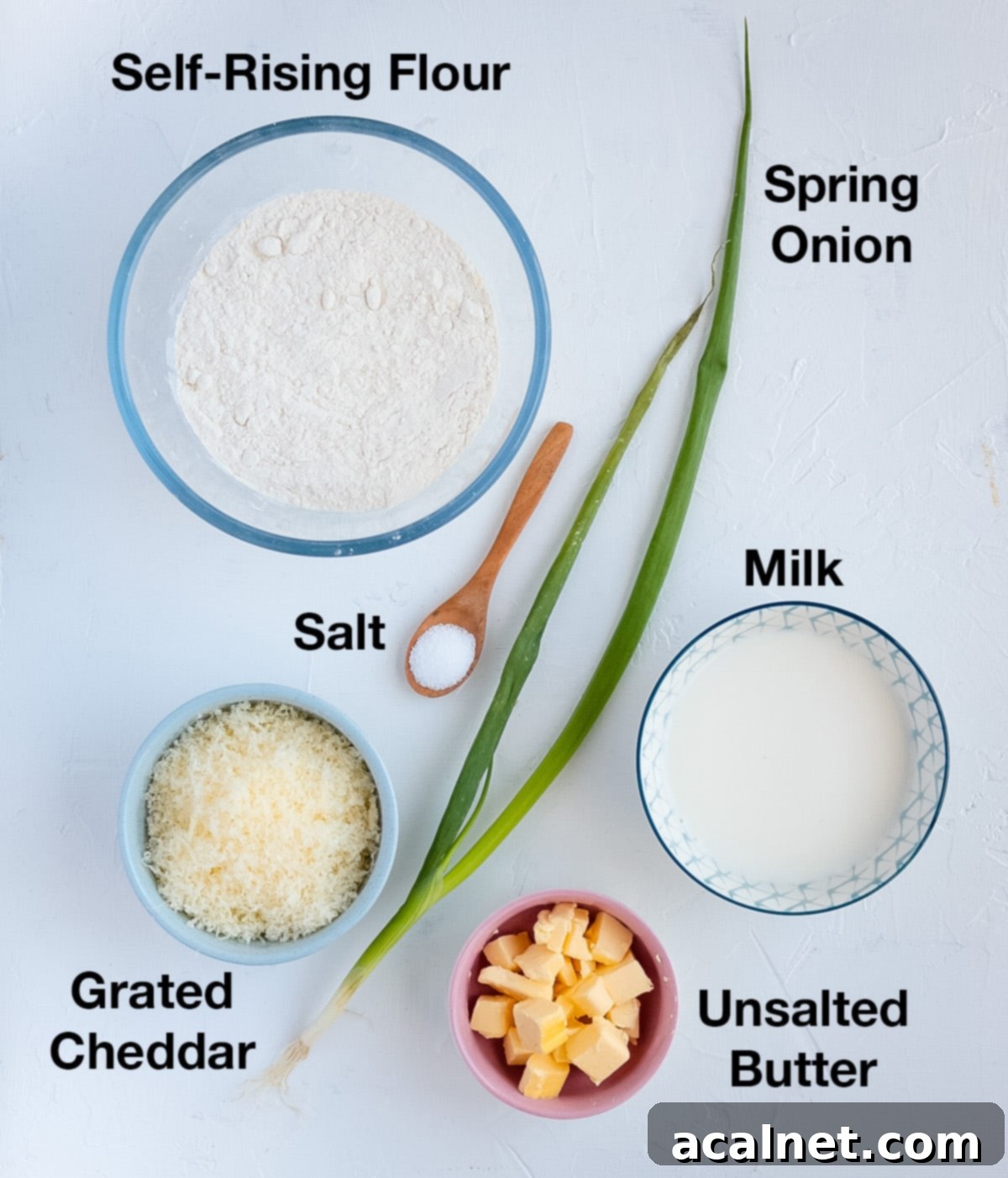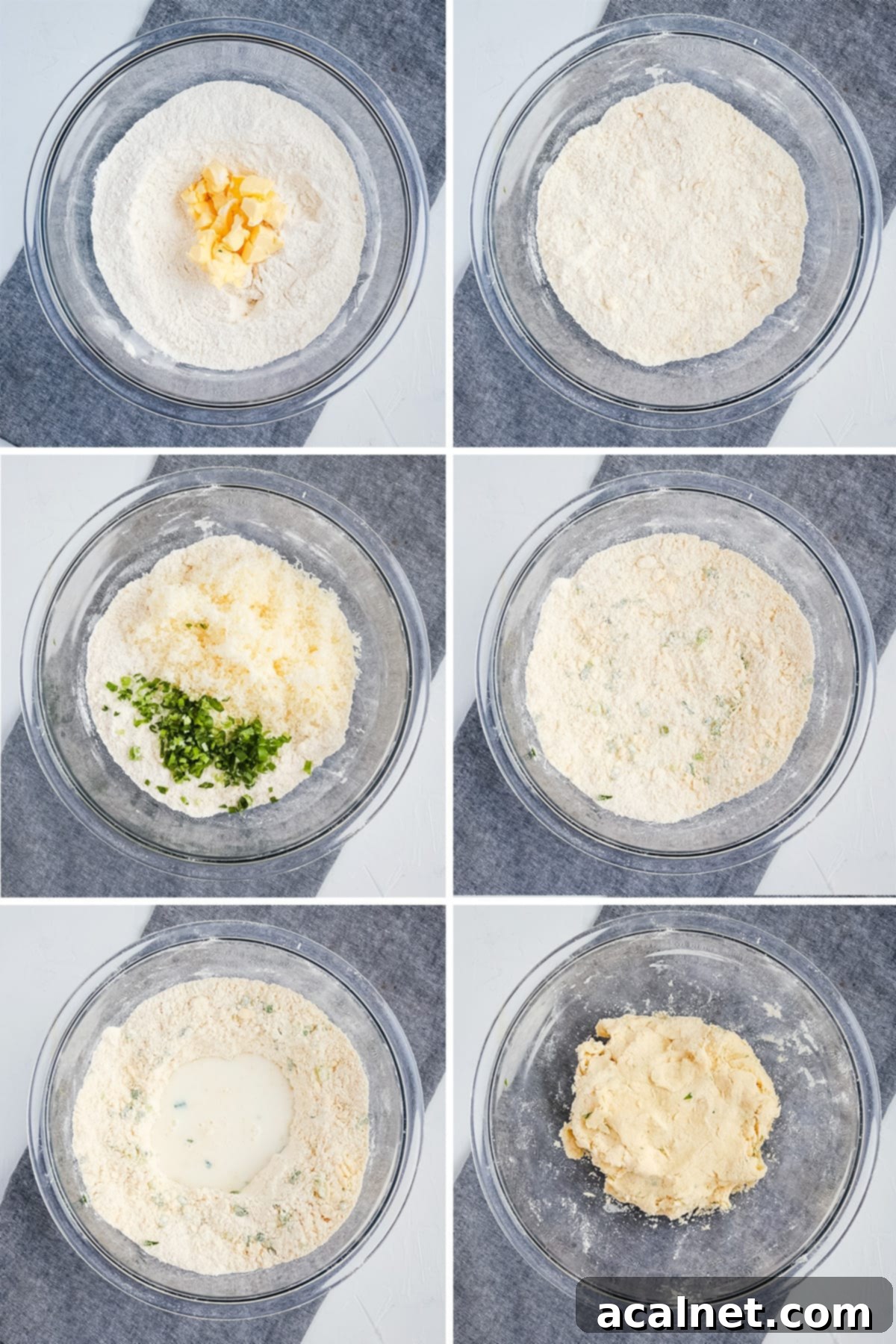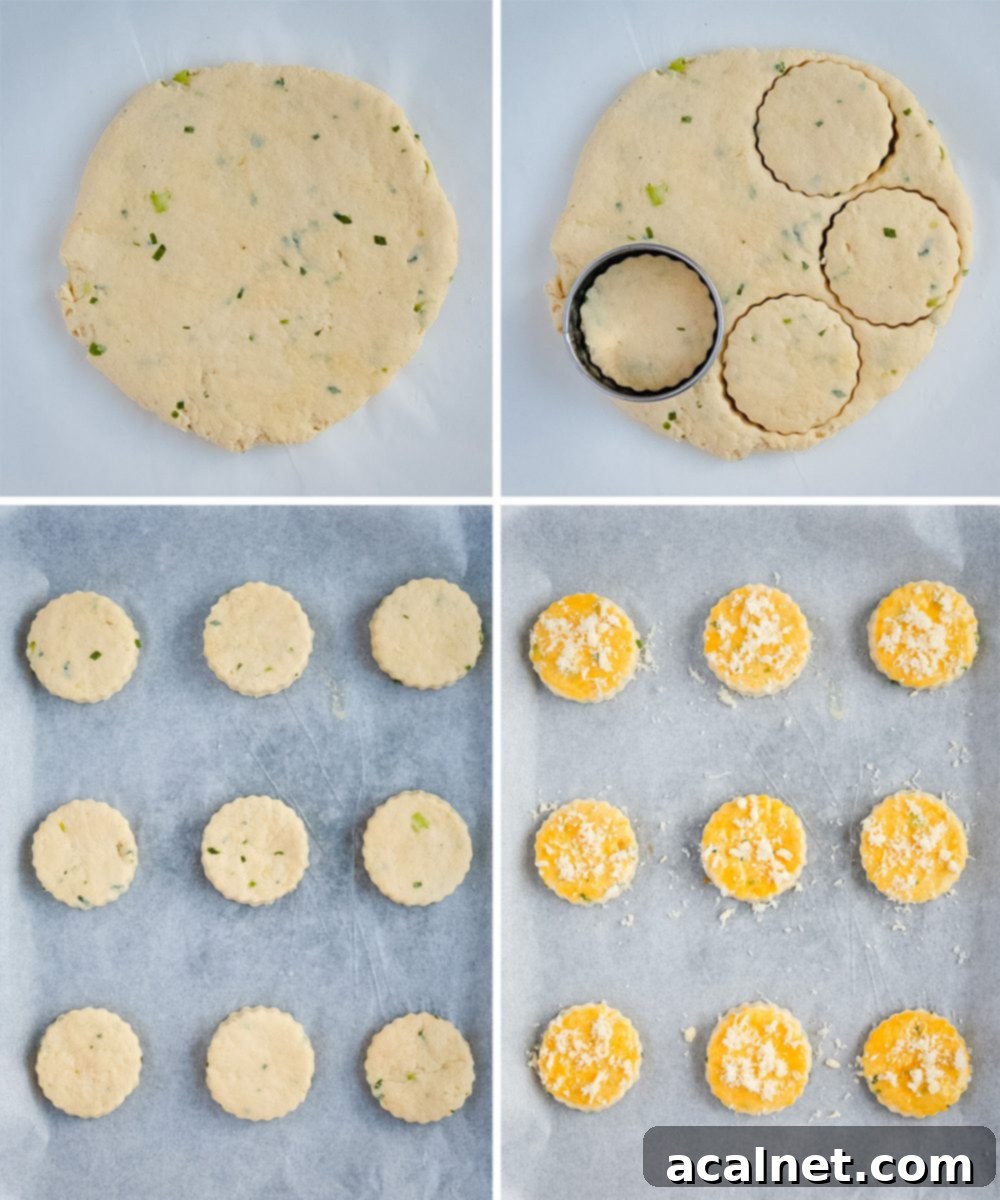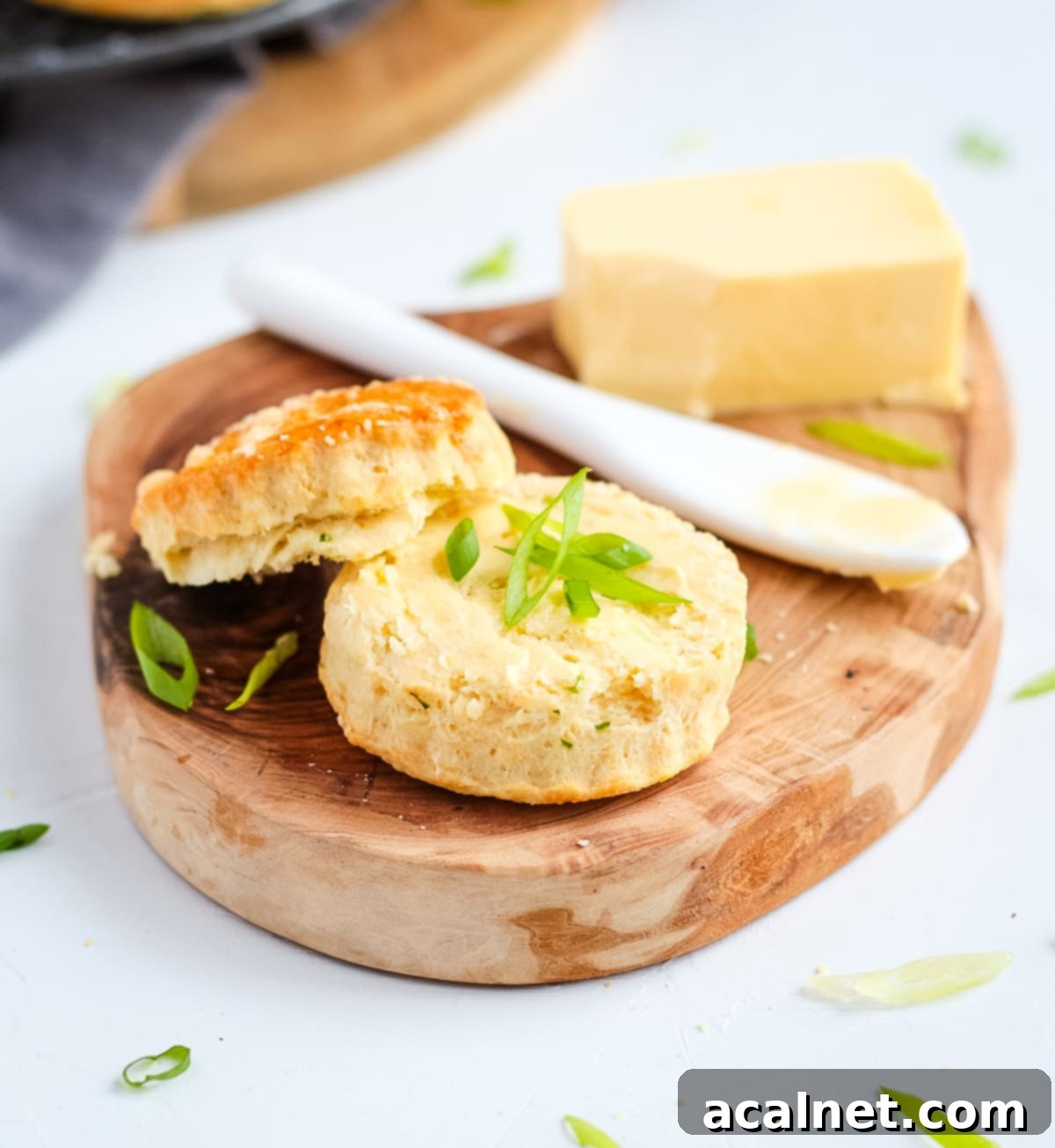Fluffy Cheddar and Spring Onion Cheese Scones: The Ultimate Savory Treat
These incredibly light and exceptionally fluffy Cheese Scones, bursting with the sharp flavor of mature Cheddar cheese and the subtle bite of fresh spring onions, are truly a delightful savory baked good. They are perfectly suited for a sophisticated afternoon tea spread, but their versatility shines through, making them an excellent choice for a hearty breakfast, a satisfying addition to any lunchbox, a quick and delicious snack, or even an elegant appetizer. Prepare to elevate your baking game with this simple yet impressive recipe!

Why You’ll Adore These Savory Cheese Scones
Scones hold a special place in the world of baking for their remarkable simplicity and incredible speed from pantry to plate. They are genuinely one of the easiest baked goods to create from scratch, requiring no elaborate equipment or tedious, lengthy steps. What’s more, they offer boundless possibilities for customization, allowing you to tailor them perfectly to your personal preferences and cravings!
Much like their sweet counterparts, such as my beloved Basic Scones, vibrant Strawberry Coconut Scones, or delightful Chocolate Chip Scones, these savory cheese and spring onion scones are astonishingly quick to prepare. You can mix the dough, roll it out, expertly shape them, and have them ready to pop into the oven in a mere 20 minutes or even less! This makes them an ideal choice for last-minute guests or when you need a quick, comforting bake.
Beyond their ease and speed, I absolutely cherish these Vegetarian Savory Scones with their harmonious blend of sharp Cheddar and delicate Spring Onions for their incredible versatility. Imagine starting your day with them for breakfast, packing them into a lunchbox for a delightful midday treat, serving them as an elegant component of an afternoon tea, enjoying them as a satisfying snack, or even presenting them as a sophisticated appetizer. Their adaptability means they fit seamlessly into any meal or occasion, proving just how truly versatile a simple scone can be!
There’s also a unique joy in transforming a beloved sweet recipe into a savory sensation. These cheese scones are a perfect example, mirroring the fun you can have with my Savory Cheese Pancakes. It’s a culinary adventure that never disappoints, proving that sweet concepts can often be reimagined into equally delicious savory delights.
Essential Ingredients for Perfect Cheese Scones

Crafting these delicious cheese scones relies on a handful of basic, readily available ingredients. However, the beauty of this recipe lies in its flexibility, allowing you to easily add other elements to customize them to your heart’s content and truly make them your own!
- Self-Rising Flour: This is the foundation of our light and fluffy scones. It contains both flour and a leavening agent, ensuring a perfect rise. If you don’t have self-rising flour, don’t worry! You can easily create your own blend using plain (all-purpose) flour and baking powder. Refer to our FAQ section below for the precise ratios and instructions.
- Salt: A crucial seasoning that enhances all the other flavors in the scone, especially the richness of the cheese. While I’ve kept it simple here, feel free to experiment with other savory additions like dried herbs (such as rosemary or thyme) or a pinch of black pepper to further elevate the taste profile.
- Unsalted Butter: The secret to a truly flaky scone is using very cold, unsalted butter. Keeping it cold ensures that the butter melts slowly in the oven, creating pockets of steam that result in those desirable flaky layers. Unsalted butter allows you to control the overall saltiness of your scones.
- Cheddar Cheese: For this recipe, I highly recommend using a sharp or mature Cheddar cheese, finely grated. Its robust, tangy flavor stands out beautifully in the scone. Finely grating it helps distribute the cheese evenly throughout the dough, ensuring every bite is packed with cheesy goodness.
- Milk: Full cream milk provides richness and helps bring the dough together, contributing to a tender crumb. However, if you prefer or require a dairy-free option, plant-based milks such as almond milk, soy milk, or oat milk will work perfectly well without compromising the texture or flavor significantly.
- Spring Onion (Scallion): These add a fresh, mild onion flavor and a vibrant green fleck throughout the scones. They provide a lovely counterpoint to the richness of the cheese.
Optional additions to consider: A touch of Mustard Powder for an extra tangy depth, Garlic Powder for a subtle savory warmth, and an Egg Yolk (mixed with a splash of milk) for a beautiful, golden-brown egg wash.
Smart Ingredient Substitutions
While the classic combination is delightful, here are some easy substitutions to adapt this recipe to your pantry or taste:
- Self-Rising Flour Alternative: If your pantry is out of self-rising flour, a simple homemade blend is your savior! Combine Plain / All-Purpose Flour with Baking Powder. The general rule is 1 ½ teaspoons of baking powder per cup (125g) of all-purpose flour. For this recipe, you would essentially double that ratio for the total flour quantity. Ensure both are well whisked together before adding other ingredients.
- Cheddar Cheese Options: My personal preference leans towards the bold, tangy notes of Cheddar cheese, as it offers a fantastic depth of flavor. However, feel free to experiment with other hard cheeses that grate easily. Gruyère Cheese, for example, offers a nutty, slightly sweet profile that melts beautifully. You could also try a sharp Parmesan for a more piquant taste, or a mixture of cheeses for a complex flavor.
- Spring Onion / Scallion Alternatives: The mild oniony crunch of spring onions is wonderful, but other fresh herbs or aromatics can be equally delicious. Finely chopped Chives would offer a delicate, garlicky-onion flavor. Alternatively, a small quantity of very finely minced Onion or Shallots can provide a more pronounced oniony punch. For those who prefer a simpler, pure cheese flavor, the spring onions can be omitted entirely, resulting in classic plain cheese scones.

Step-by-Step Guide: Crafting Your Own Savory Cheese Scones
Making these delightful Mini Cheese Scones is a surprisingly easy and incredibly straightforward process. The recipe is generally divided into two main stages: first, preparing the scone dough, and then shaping it before baking. Follow these steps for perfect, golden-brown results every time!
Mastering the Scone Dough
- First things first, gather all your dry ingredients. Place the Self-Rising Flour, Salt, and any optional dry spice powders you’re using (like Mustard Powder and Garlic Powder, as suggested) into a large mixing bowl. Take a moment to whisk these together thoroughly. This ensures all the leavening agents and flavorings are evenly distributed, leading to a consistent rise and taste in every scone.
- Next, introduce the cold butter. Slice your very cold unsalted butter into small cubes, or for an even more consistent distribution and faster incorporation, some bakers prefer to grate the butter directly into the flour. Now, it’s time to “cut” the butter into the flour. You can achieve this using various methods: your hands (rubbing the butter and flour between your fingertips), a dedicated Pastry Blender, or even a Food Processor for a quick, hands-off approach. The goal is to work the butter into the flour until it resembles coarse crumbs, with some pea-sized pieces of butter remaining. All the flour should be coated with these small chunks of butter, which will create the desired flaky texture when baked.
- Once your butter is perfectly incorporated, add the finely grated Cheddar Cheese and the thinly chopped Spring Onion (Scallion) to the mixture. Give it another quick stir with your whisk or spatula to ensure these delicious additions are evenly distributed throughout the buttery flour mixture.
- Finally, it’s time to bring the dough together. Create a slight well in the center of your dry ingredients and pour in the Full Cream Milk. Using a spatula, a wooden spoon, or even your clean hands, gently work the milk into the dry ingredients. Continue mixing until a cohesive dough just starts to form and you can no longer see any dry pockets of flour.
Important Tip: It is absolutely crucial at this stage not to overwork the dough. Over-mixing develops gluten, which can lead to tough, hard scones rather than the light and tender texture we’re aiming for. The dough might appear slightly shaggy or not perfectly homogeneous at this point, but trust the process – it will come together beautifully when you roll it out.

Perfectly Shaping Your Scones for Baking
The second exciting part of this recipe involves shaping your scone dough into those characteristic, appealing forms. There’s a wonderful variety of ways to shape scones, often resulting in either a traditional triangular wedge or the more commonly seen round shape. For this particular recipe, I’ve opted for rolling out the dough and using a round fluted cookie cutter to create elegantly shaped scones.
- Begin by gently transferring your scone dough onto a lightly floured surface. Alternatively, for a much less messy cleanup in your kitchen, lay down a large sheet of baking paper – this is my preferred method! Carefully bring the shaggy dough together into a cohesive ball, then gently flatten it with your hands to prepare it for rolling.
- Using a rolling pin, carefully roll the dough into a flat, even disk. Aim for a thickness of approximately 2 cm (or about ¾ inch). If you find the dough is sticking to your rolling pin, a very light dusting of flour over the dough can help, or you can simply place another sheet of baking paper over the top of the dough before rolling.
- Now, it’s time to cut your scones! Choose your preferred cookie cutter – either a simple round one or a decorative fluted one. I typically use a 7cm (2.5-inch) cookie cutter to yield about 9 small, perfectly portioned scones. If you desire larger, more substantial scones, feel free to use a slightly bigger cutter. Remember to press straight down without twisting the cutter to ensure a good rise.
- Pro Tip for Leftover Dough: Any dough scraps can certainly be re-rolled to make additional scones. However, for the best texture and to prevent shrinkage, it’s highly recommended to gather the leftover dough, gently knead it once or twice just to bring it together, and then let it rest in the fridge for at least 15 minutes before re-rolling and cutting more scones. This allows the gluten to relax.
- Carefully transfer your freshly shaped scones onto a large, flat baking tray that has been lined with baking paper. Ensure there’s a little space between each scone for even baking.
- Optional Golden Finish: For that classic, enticing golden-brown crust, whisk one Egg Yolk in a small bowl. You can add a tiny splash of milk to loosen it slightly if desired. Then, gently brush this egg wash over the top surface of each scone. This not only imparts a beautiful color but also adds a subtle sheen.
- Optional Cheesy Topping: For an extra burst of savory flavor and a gorgeous grilled cheese finish, sprinkle a small amount of additional grated Cheddar Cheese over the top of each scone after applying the egg wash (if using).
- Finally, preheat your oven to 180°C (350°F). While your oven is coming up to temperature, place the baking tray with your shaped scones into the fridge. Chilling the dough before baking helps the butter stay cold, contributing to a better rise and flakier texture.
- Bake for approximately 18 to 20 minutes. The exact baking time may vary slightly depending on your specific oven and the size of your scones, so keep an eye on them. They are ready when they have puffed up beautifully and are gorgeously golden brown on top. Once baked, carefully transfer them to a wire cooling rack. Allow them to cool slightly before serving, though they are absolutely divine warm from the oven!

Pro Tips for Achieving the Best Savory Scones Ever
- Always use very Cold Butter: This is arguably the most critical tip for flaky scones. Cold butter creates pockets within the dough. As the scones bake, these pockets of butter melt and release steam, pushing the layers of dough apart and resulting in that coveted light, airy, and flaky texture. For an extra boost of flakiness, try chilling your shaped scones in the fridge for 15-20 minutes before baking.
- Do Not Overwork the Dough: Handling the dough too much is the enemy of tender scones. The more you mix or knead the dough, the more gluten develops. Gluten is what gives bread its chewiness, but for scones, it leads to a tough, hard crumb. Mix just until the ingredients are combined and no dry flour remains. If you accidentally overwork the dough a little, letting it rest in the fridge for 10-15 minutes can help the gluten relax slightly.
- Rest Leftover Dough Before Re-rolling: If you’re re-rolling dough scraps to make extra scones, always let the dough rest in the fridge for 10 to 15 minutes first. This crucial step allows the gluten to relax after being handled, ensuring that your subsequent scones don’t shrink back or pull in excessively when they bake, maintaining a good shape and texture.
- Avoid Excessive Flour During Rolling: When rolling out your dough, use flour sparingly. The dough should feel slightly wet and sticky to the touch. Adding too much flour can dry out the dough, resulting in heavy, dense scones. If the dough is genuinely difficult to handle due to stickiness, add just a tiny dusting of flour to your surface or rolling pin, or use baking paper as a barrier.
- Utilize an Egg Wash for a Beautiful Finish: Brushing the tops of your scones with a whisked Egg Yolk (an “Egg Wash”) before baking is a simple yet effective way to achieve a gorgeous, glossy, golden-brown crust. You can add a teaspoon of milk or water to the egg yolk to make it easier to brush evenly.
- Cut Straight Down, No Twisting: When using a cookie cutter, press it straight down into the dough and lift it straight up. Twisting the cutter can seal the edges of the scone, which hinders its ability to rise fully and evenly, potentially leading to lopsided or less fluffy results.
Frequently Asked Questions About Savory Scones
Absolutely! If you don’t have self-rising flour on hand, it’s incredibly easy to create your own effective substitute at home using plain/all-purpose flour, baking powder, and a pinch of salt. The standard ratio is typically:
– Plain/All-Purpose Flour: 1 cup (about 125-150 grams)
– Baking Powder: 1 ½ teaspoons (about 6 grams)
– Salt: A small pinch (about ¼ teaspoon)
For this specific recipe, you would need to adjust these quantities to match the 250 grams (1 2/3 cups) of self-rising flour required. So, you would roughly double this formula. Always whisk these ingredients together very thoroughly before adding the butter and other wet ingredients to ensure the leavening agent is evenly distributed. Any leftover homemade self-rising flour mix can be stored in an airtight container for future use.
Cheese scones are wonderfully versatile and can be paired with many delicious accompaniments! While they are truly delicious eaten plain and warm, fresh from the oven, there are many ways to enhance your enjoyment. My personal favorite is a simple spread of soft Butter, perhaps a tiny sprinkle of flaky Sea Salt for texture, and some freshly chopped Spring Onions for an extra burst of freshness. The richness of the butter perfectly complements the tangy cheese.
For a creamier experience, you could also serve them with a generous dollop of spreadable cheese like Cream Cheese, or even a soft goat cheese for a slightly tangier flavor. They are also fantastic with your favorite savory dips! Imagine them alongside a vibrant, freshly made Pesto sauce, a rich tomato relish, a tangy chutney, or even a creamy hummus. For a heartier option, they make a perfect side to a bowl of warm soup or a light salad. Don’t be afraid to get creative!
Absolutely! This recipe is incredibly adaptable to various flavor additions. Beyond mustard and garlic powder, you could incorporate finely chopped fresh herbs like rosemary, thyme, or chives directly into the dry ingredients for an aromatic boost. A pinch of cayenne pepper or a dash of smoked paprika can add a lovely warmth and subtle kick. For a Mediterranean twist, consider adding a tablespoon of finely chopped sun-dried tomatoes or olives. Always ensure any additions are finely chopped to distribute evenly and bake properly.
Achieving tall, proud scones is a common goal! Here are a few key tips: 1. Use Cold Ingredients: Especially butter and milk. Cold butter creates steam pockets for a good rise. 2. Don’t Overwork the Dough: Mix just until combined. Overworking develops gluten, leading to a flatter, tougher scone. 3. Roll to Proper Thickness: Aim for about 2 cm (¾ inch) thick. 4. Cut Straight Down: Press your cutter straight down without twisting. Twisting seals the edges and can inhibit rising. 5. Chill Before Baking: Placing the shaped scones in the fridge while the oven preheats helps keep the butter cold, leading to a better “oven spring.” 6. High Oven Temperature: A hot oven helps the scones rise quickly and create a crust before spreading too much.

Storing & Freezing Your Savory Cheese Scones
Preparing Scones Ahead of Time
While these cheese scones are truly at their best when enjoyed fresh and warm from the oven, they can certainly be prepared in advance to save you time. You have the flexibility to make the dough and shape your scones up to 24 hours before you plan to bake them. Simply arrange the shaped, unbaked scones on a flat baking tray, cover them loosely with plastic wrap, and store them in the fridge until you’re ready to bake. This is a fantastic option for entertaining or for a quick breakfast on a busy morning.
Important Note: If you choose to store the scones raw in the fridge, it’s best to apply the optional egg wash and grated cheese topping just before they go into the oven, rather than beforehand. This ensures the best appearance and texture for the topping.
Optimal Storage for Baked Scones
Once baked and cooled, these savory scones can be kept at room temperature in an airtight container for up to 2 days. To maintain their best quality, try to avoid storing them in the refrigerator, as the cold air tends to make them dry out and become hard much more quickly. If they do become a little firm, a quick reheat in a warm oven or microwave can help revive their tenderness.
Can I Freeze Cheese Scones?
Yes, absolutely! These cheese scones freeze beautifully, whether you prefer to freeze them baked or unbaked. For the freshest and most delightful result, I highly recommend freezing them unbaked. This allows them to have a perfect “oven spring” and fluffiness when you eventually bake them fresh.
- Freezing Un-baked Scones: This is the gold standard for freezing. After shaping your scones (and before applying any egg wash or cheese topping), place them in a single layer on a flat baking tray lined with baking paper. Pop the tray into the freezer until the scones are completely solid – this usually takes a few hours. Once frozen solid, transfer them into a freezer-friendly airtight container or a heavy-duty freezer bag. To prevent them from sticking together, you can separate layers with small pieces of baking paper. When ready to bake, there’s no need to thaw! Simply bake them directly from frozen, adding an extra 5 to 10 minutes to the recommended baking time until they are puffed and golden.
- Freezing Baked Scones: If you’ve already baked a batch and want to save some for later, let them cool down completely to room temperature first. Then, place them into a freezer-friendly container or a sturdy freezer bag. Again, separating them with baking paper, foil, or plastic wrap will prevent them from sticking. To thaw, you have a couple of options: either leave them to defrost in the fridge overnight, or for a quicker method, place them directly into a preheated oven (around 160°C/325°F) for about 5-10 minutes until warmed through and slightly crisp on the outside.

Explore More Delicious Small Savoury Bakes
- Spinach and Ricotta Rolls
- Zucchini Muffins with Goat’s Cheese
- Cheddar and Spinach Muffins
- Cheese Gougères (Classic French Cheese Puffs)
- Savoury Dried Tomato Madeleines
- Sweet Potato Bread Buns
Made this recipe?
We’d love to hear from you! Let us know if you enjoyed these delectable cheese scones by leaving a comment below. Don’t forget to tag us on Instagram @a.baking.journey with a photo of your fantastic culinary creation!
Recipe Card

Fluffy Savory Cheese Scones with Cheddar & Spring Onion
Servings:
9
Small Scones
Author:
Sylvie
15
minutes
20
minutes
35
minutes
Print Recipe
Prevent your screen from going dark
Ingredients
Cheddar Scones
-
250
gr (1 2/3 cup)
Self-Rising Flour -
1
tsp
Salt -
60
gr (1/4 cup)
Unsalted Butter -
50
gr (1/2 cup)
Cheddar Cheese,
finely grated -
1
Spring Onion / Scallion, thinly sliced -
120
ml (1/2 cup)
Full Cream Milk
Optional Additions
-
1/2
tsp
Mustard Powder -
1/2
tsp
Garlic Powder -
1
Egg Yolk,
for Egg Wash
Instructions
- In a large mixing bowl, combine the Self-Rising Flour, Salt, and any optional dry spice powders (such as Mustard Powder and Garlic Powder, if you’re using them). Whisk these dry ingredients together thoroughly to ensure even distribution.
- Add the very cold Unsalted Butter, which you’ve sliced into small cubes (or grated). Gently cut the butter into the dry ingredients using your fingertips, a pastry blender, or a food processor. Continue until the mixture resembles coarse crumbs with some pea-sized pieces of butter still visible, ensuring all the flour is coated.
- Now, whisk in the finely Grated Cheddar Cheese and the thinly chopped Spring Onion. Mix quickly to combine these additions evenly throughout the flour-butter mixture.
- Make a well in the center of the bowl and pour in the Full Cream Milk. Using a spatula or your hands, gently incorporate the dry ingredients with the milk until a shaggy dough just begins to come together and no dry flour remains. Be careful not to overwork the dough at this stage.
- Transfer the dough onto a lightly floured surface (or a large sheet of baking paper for easier cleanup). Gently bring the dough together into a ball and then roll it into a flat disk, approximately 2 cm (¾ inch) thick.
- Using a 7 cm (2.5-inch) Round or Fluted Cookie Cutter, cut out the scones by pressing straight down and lifting. Place the cut scones onto a flat baking tray lined with baking paper, ensuring they are slightly spaced apart.
- Any leftover dough scraps can be gently re-rolled and cut into more scones. However, for the best results, it is highly recommended to let the dough rest in the fridge for 10 to 15 minutes before re-rolling to allow the gluten to relax.
- Preheat your oven to 180°C (350°F). While the oven is preheating, place the baking tray with your shaped scones into the fridge. This chilling step helps promote a better rise.
- Optional: Once your oven reaches the desired temperature, whisk the egg yolk in a small bowl (you can add a splash of milk to make it lighter if preferred). Brush this egg wash gently over the top of each scone to achieve a beautiful golden color. For an extra cheesy crust, sprinkle a little more grated Cheddar over the egg wash.
- Bake for approximately 20 minutes, or until the scones are beautifully puffed up and golden brown on top. Baking time may vary depending on your oven and scone size. Carefully transfer the baked scones onto a cooling rack and allow them to cool slightly before serving for the best texture.
Would you like to save this recipe?
We’ll email this post to you, so you can come back to it later!
Notes
Recipe Yield: This recipe is designed to yield approximately 9 Small Scones when using a 7cm (2.5-inch) cutter, or about 6 Larger Scones if you opt for a bigger cutter.
- It is paramount to use very cold butter to achieve that desired flaky, light texture. I prefer to cut my butter into small cubes, but grating it finely into the flour is another excellent technique that some bakers swear by for even distribution and minimal handling.
- To keep your kitchen tidier and simplify cleanup, I often cover my workbench with a sheet of baking paper before handling and rolling the dough. This creates a non-stick surface and contains any flour or dough residue.
- For perfectly portioned small scones, I typically use a 7 cm / 2.5 inch fluted cookie cutter. If you prefer a more substantial scone, feel free to use a slightly larger cutter; just be aware that this will reduce the total yield.
- The baking time provided is an estimate. It could take a little bit longer or shorter depending on the exact size and thickness of your scones, as well as the calibration and efficiency of your individual oven. Always bake until golden brown and well-risen.
Nutrition (per serving)
Calories:
187
kcal
|
Carbohydrates:
21
g
|
Protein:
6
g
|
Fat:
9
g
|
Saturated Fat:
5
g
|
Cholesterol:
43
mg
|
Sodium:
301
mg
|
Potassium:
51
mg
|
Fiber:
1
g
|
Sugar:
1
g
|
Vitamin A:
286
IU
|
Vitamin C:
1
mg
|
Calcium:
63
mg
|
Iron:
1
mg
